-
Hungarian food
 Ever since my 3 years in Budapest, I have been regularly cooking Pörkölt with the delicious sweet, but hot, peppers from Hungary. We now grow these peppers or “paprikas” in the garden here in France.
Ever since my 3 years in Budapest, I have been regularly cooking Pörkölt with the delicious sweet, but hot, peppers from Hungary. We now grow these peppers or “paprikas” in the garden here in France.In fact “goulash” in Hungarian is more often used as the version of this dish as a soup. This is how I make it:
– Fry two or three large onions, sliced
– Add your meat (beef, veal or chicken) diced into bite sized pieces
– When the meat is browned, add both sweet and hot Hungarian paprika powder (the amounts depend on how spicy hot you want it to be)
– Add some ground caraway seeds also
– When the spices have impregnated the meat, add some diced tomatoes (or tomato pulp from a can) and red wine (or white wine if you are using chicken)
– Sometimes I add chopped carrots as well
– Season with salt, cover and cook in a low oven (150°C) for 2 hours
– Serve with rice or steamed potatoes and decorate with chopped marjoram and sour cream
– As a variation, and to replace the rice, I sometimes add cooked sauerkraut cabbage for a few minutes at the end.
– You can also make this dish with fish but, in this case, cook the sauce first for about 45-60 minutes until it starts thickening and tasting good, then add the fish at the end. -
Lomo and grilled vegetables
 This is incredibly easy to do on the plancha.
This is incredibly easy to do on the plancha.For those of you that don’t know, a “plancha” is a thick cast iron plate that you heat up on the stove. You can grill practically anything on it. Mosts planchas have a flat side and a ribbed side, for this recipe I used the ribbed side which give the meat that criss-cross design you see in the picture.
Slice your vegetables into ribbons, I used green asparagus and courgettes but you could also use aubergines or peppers. Toss the vegetables in some olive oil and grill on the plancha turning frequently. Actually this way of “searing” the vegetables really gives them flavor.
When the vegetables are nearly ready grill the thin slices of pork on both sides.
Toss the warm vegetables in a vinaigrette made with honey, mustard, balsamic vinegar and olive oil. Serve with the grilled meat and decorate with thyme, rocksalt and some crumbled goats cheese or gorgonzola.
-
Easter Fajitas
 My friend Lionel Heath owned a Tex-Mex restaurant in Cannes and is the inspiration for this Mexican spread which I always include in my Around the World cookery weeks and my Introduction to Cooking with Spices Courses.
My friend Lionel Heath owned a Tex-Mex restaurant in Cannes and is the inspiration for this Mexican spread which I always include in my Around the World cookery weeks and my Introduction to Cooking with Spices Courses.There are probably many variations on this recipe, the most important thing is to have a cast iron plancha or griddle:
– make some soft totillas with white flour (or a mix of white flour and maize flour), sugar, a little yeast, warm water, a little cooking oil, and salt. Let the dough stand in a warm place.
– marinate chicken (or beef) pieces in lemon juice, honey, olive oil, ground chilli and ground coriander seeds
– roll out tortilla dough (about 30g per tortilla) on a floured surface. Cook for just a minute or so on each side on a very hot griddle (flat side upwards). Put aside and keep warm.
– wipe off any excess flour and heat a little olive oil on the plancha/griddle. Cook some chopped onions and peppers with the marinated chicken pieces, keep turning so the meat is seared on all sides, it just take a couple of minutes so long as the plancha is hot enough
– decorate with chopped coriander and serve with shredded lettuce, tomato salsa, greeted cheese and sour cream (made from french cream, fromage blanc and lime juice) all rolled up together in a tortilla.This recipe is great fun, children especially enjoy it.
-
West Indian cuisine


Research for the cookbook is coming along just great. I thought maybe some of you would like a fore taste
 First the coleslaw:
First the coleslaw:
– Shred white cabbage, onions, lettuce and carrots
– Make the salad sauce with lime juice, honey, mustard, olive oil and mayonnaise (out of a jar)
– decorate with slices of mangoDolphin fish is not dolphin, it’s a big fish with a green/yellow underbelly and a flat head
– bone the fish and cut into thick chunks
– fry the chunks
– when browned add some West Indian curry powder, some chili sauce and some tomato sauce, cover to cook through
– pour rum into the pan and set fire to the whole thing
– serve with mashed potato mixed with mashed edoe (if you can find some) shaped into the form of a volcano, pour a little of the tomato sauce into the cone like lava. -
Welsh Rarebit
I went to Bordeaux this week, nice town? We ended up in a pub who served “Welshes” as a speciality. These were nothing like the Welsh rarebit my mum used to make when I was a boy but I found this snack concept quite interesting – I had a “welsh” with Basque espelette chillies, it was really wonderful.
So returning home I improvised the following recipe – you can improvise on this concept depending upon what you have in the fridge.
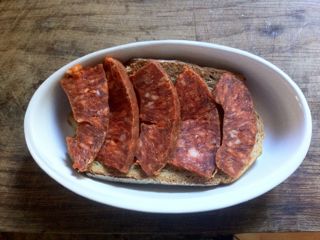


Put a slice of bread in the bottom of an ovenproof dish. Slice some chorizo. Place the chorizo (or ham coated with mustard) on top of your slice of bread Cover with grated cheese, cheddar, swiss, or any cheese. Add a little beer or white wine. Place in a hot oven or under the grill for 6-7 minutes, break an egg over the dish after 2-3 mins. -
More Pizzas
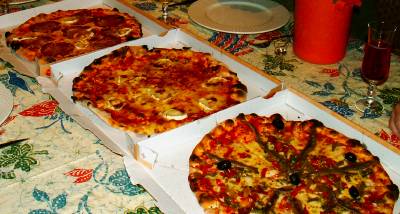 As mentioned in previous posts here, we have a wonderful pizza shop in town. In fact Bruno, who runs the place single handed, has just been voted number 1 pizza chef Champion of France.
As mentioned in previous posts here, we have a wonderful pizza shop in town. In fact Bruno, who runs the place single handed, has just been voted number 1 pizza chef Champion of France.This is his latest masterpiece, on a pizza base cooked with a mixture of wild mushrooms he places slices of melon, cherry tomatoes, buffalo milk mozzarella and salad.
Great for the summer, in fact we have been eating this pizza almost every Sunday since July (I should have posted the photo long ago).
-
Salmon and cucumber salad

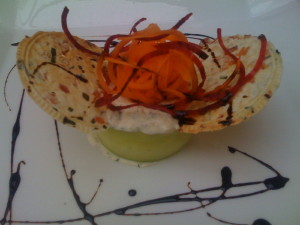 I invented this starter for Sunday lunch this week. I confess it was a little inspired by the crab mousse with smoky ham wafers which I tasted at Les Quatre Saisons restaurant in Sarlat la Caneda (photo right).
I invented this starter for Sunday lunch this week. I confess it was a little inspired by the crab mousse with smoky ham wafers which I tasted at Les Quatre Saisons restaurant in Sarlat la Caneda (photo right).For my version I used diced smoked salmon, shredded carrots, chopped red onion and cucumber chunks. Mix all these ingredients in a light mayonnaise with added mustard, lots of dill, olive oil and lemon juice.
First, make some ribbons of cucumber with a potato peeler, as long as possible along the whole length of the cucumber. Wrap these around a yoghurt pot (or anything round, you can find special stainless steel rings in some professional cookery shops which, obviously, is the best and can be used for all sorts of other recipes), three or four ribbons per plate, to make some round cucumber “crowns”. Fill with the salmon and carrot mixture and decorate as you want.
-
Garlic Chicken
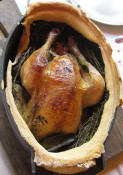 This is a recipe that I think originally came from Jean-Baptiste Reboul’s book La Cuisinière Provençal written in 1910. If you can find this book anywhere, buy it. It starts with a whole chapter on the concept and theory of Pot au Feu.
This is a recipe that I think originally came from Jean-Baptiste Reboul’s book La Cuisinière Provençal written in 1910. If you can find this book anywhere, buy it. It starts with a whole chapter on the concept and theory of Pot au Feu.This is dead easy. You need a cast iron of earthenware pot with a lid. Start by placing 40 or 50 unpeeled cloves of garlic in the bottom of the pot with a little olive oil. In French we call this “ail en chemise”, garlic with its shirt on. Separate the cloves from the head of garlic but do not peel them. And yes, I said forty or fifty cloves of garlic, more if you want.
Place a chicken (with some lemon slices inside the cavity) on top of the “pearly bed” of garlic and place the pot under a hot grill in the oven (without the lid on) – this serves to brown and crisp the chicken on top.
While your chicken is getting crisp under the grill (just a few minutes) mix some flour and water to make a bread dough. Remove the pot from the oven when the chicken is nicely browned, stuff all the fresh herbs you can find around the chicken (rosemary, sage, parsley, thyme, basil, whatever you’ve got), add some salt and pepper, and place the lid on the pot. Seal the lid hermetically onto the pot with the bread dough all around the joint and place back in the oven (normal oven settings, switch off the grill) at 160 degrees for 1 hour and a half or two hours, more for a big chicken. The idea is to cook everything slowly inside the sealed pot and enable the garlic cloves to stew in the juices.
Bring the pot onto the table and break open the bread dough around the lid to release the fabulous aroma of garlic and herbs when you open the pot. The stewed garlic cloves pop out of their peel like butter, spead onto country style bread and eat with the chicken.
-
Stuffed Courgette Flowers
 This is a tricky recipe because the flowers are very delicate and you must be very careful not to damage them.
This is a tricky recipe because the flowers are very delicate and you must be very careful not to damage them.
You have to choose very fresh baby courgettes. Wash the courgettes and flowers in cold water and carefully dry them with kitchen roll. There is a debate about removing the pistils inside the flowers or not: personally I remove them because this allows more space for the stuffing.
Dice the baby courgettes leaving about 2cm on the flowers. You can leave the whole baby courgette with the flower but in this case you need to cook everything a little longer in the oven (unles you like your courgettes al dente.
Prepare your stuffing. I make a sausage meat stuffing and add the diced courgettes but you can use your imagination here (blue cheese and hazelnuts is quite a good one). Bind your cooked stuffing with an egg and add lots of fresh basil.
Delicately stuff the flowers and lay them on an oven dish. Add a couple of diced tomatoes to the remaining stuffing and surround the flowers with the mixture. Sprinkle parmesan cheese on top, cover with tin foil, and cook in the oven at 180 degrees for 20 minutes. -
This years chillies




This years chillies are coming along well. From left to right: Jamacian yellow, Espelette, Hongarian goulasch, Cayenne
-
Orto di Venezia
 This is the wine from Venice where I went grape picking earlier this year
This is the wine from Venice where I went grape picking earlier this yearThe 2008 vintage is obviously not bottled yet, but I drank some 2006 and 2007 just last week in Paris, accompanied by a delicious topinambour (Jerusalem artichoke) soup with truffles. I’ll try to get the recipe from the lovely cook Emmanuelle Jary who, among other things, writes food and travel articles for people like Air France magazine (see here) and is a truffle expert.
The Orto di Venezia wine website is now up on line in three languages. You can find out all about this exceptional wine and find out where it is available. Any restaurants wishing to carry this wine on their winelist can send a request from the contact page on the website. The address is http://www.ortodivenezia.com.
Meanwhile back in French truffle country myself (no truffles yet, they come early in the year), I have finally got my ancient motorbike fixed with considerable difficulty and various spare parts purchased on eBay (6 volt lamps and coil, new saddle, brake cable). I went to Rocamadour yesterday in glorious sunshine (though it was a bit cold) and the bike works fine despite struggling a little on some of the steep hills. I nevertheless got up to 90km/h on a straight (ok, slightly downhill) piece of road. I will post photos and more about this antique vehicle at some stage in the future.
-
Roghan Josh
 Finally getting around to posting some more of my recipes, here is a classic Indian curry which I mentioned in a previous post last year
Finally getting around to posting some more of my recipes, here is a classic Indian curry which I mentioned in a previous post last yearThe secret with all Indian curries is to freshly grind all your spices.
For this recipe I used cardomone, cinnamon, cloves, chilli peppers, cumin seeds and poppy seeds ground up and then made into a paste with some garlic cloves and fresh ginger.
– fry some onions in a wok (or large pan)
– add some diced lamb, I use a saddle or shoulder for this, a leg of lamb is also good but more expensive of course. Brown the meat
– Add the spice paste and coat all the ingredients well, avoid that the spice burn so lower the heat
– Add some chopped tomatoes then slowly stir in some natural yoghurt
– Cook on a low heat for 45 minutes or more, until the lamb is tender
– Serve on a bed of rice and garnish with plenty of fresh coriander -
Lolita
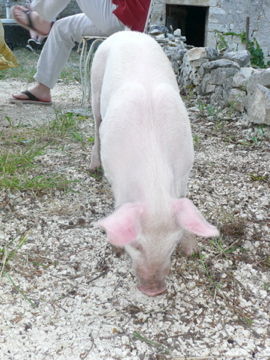 This is our neighbour’s pig, Lolita
This is our neighbour’s pig, LolitaI feel somewhat guilty in putting this wonderful animal in the cooking section of this website but I fear she will inevitably end up on our dinner table one of these days
She has a little house under an oak tree, she eats acorns and all sorts of other stuff, and she makes a lot of noise.
But she is very domesticated, she has taught herself how to open the front door so she comes into the house from time to time to have a chat(or rather an oink) with the dog.
Has a brush with a wild boar last night coming home in the dark? Huge animal but fortunately no damage, just lots of mud on the front and side of the car
The thought did cross my mind, maybe Lolita might like a husband?
Does that work???? -
Melanzane Alla Parmigiana
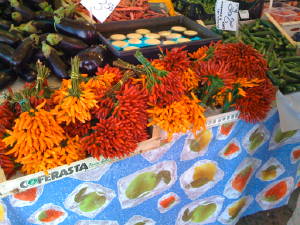 This is a nice photo of chillies from the market in Venice, sadly no fish though as it was Monday.
This is a nice photo of chillies from the market in Venice, sadly no fish though as it was Monday.Nothing whatsoever to do with chillies, one of the more pleasant encounters of the Venice trip this time was the cook Pamela who made us the most delicious pasta (her seafood pasta was especially memorable) and numerous other “mediterranean” dishes.
Pamela’s Parmesan Aubergines (Melanzane Alla Parmigiana) was one of the highlights. Here is her recipe:
– coat some aubergine slices in flour and fry them in some olive oil, set aside.
– in a baking dish, assemble layers of tomato sauce, parmesan cheese (freshly grated, not that awful stuff out of a packet), fried aubergines, mozzarella cheese and parma ham.
– repeat process for three or four layers depending on the size and depth of your baking dish.
– Top with grated parmesan.
– Cook in a hot oven for 30-40 minutes until lightly browned and cooked though. -
Tournedos Rossini
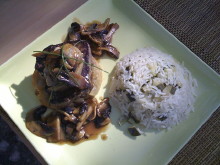 Tournedos Rossini is a classic recipe but every chef has his own version.
Tournedos Rossini is a classic recipe but every chef has his own version.
Here is mine:
– first the foie gras topping: the best is a fresh foie gras which you cut into small escalopes, one thin slice per steak. You fry the escalopes just a few seconds in a very hot frying pan without any oil. Set them aside on a warm plate.
– if you don’t have fresh foie gras, use a thin slice of foie gras entier out of a jar, there is no need to cook it, just place on top of each steak in the pan (see below), it will warm through when you cover the pan. However you will need a little duck fat in the frying pan to start as follows.
– now fry some slices of French country bread in the juices that the foie gras has left in the frying pan. Fry until lightly crisp and set aside with the escalopes.
– now fry the tournedos steaks in the same pan. Add lots of pepper.
– turn the steaks when cooked on one side and place a piece of foie gras on top of each, add sliced mushrooms to the pan. Add a touch of cornflour dissolved in some warm water (this absorbs the duck fat) and some Madeira (or any other cooked wine, the quantiy depends on the number of tournedos steaks and the size of the pan).
– Cover the frying pan and cook for a couple of minutes until the steaks are cooked through, the mushrooms cooked and the sauce starts to thicken (cooking time depends a little on how you like your steaks)
– place a slice of fried country bread on the plate, add the cooked steaks with their foie gras topping on top and pour over the mushroom/Madeira sauce.
– Serve with rice cooked with some chopped courgettes, or a potato gratin. -
FOUR-CHEESE MACARONI & CHEESE
Delicious contribution from Nicki Dennis
– 2 tablespoons unsalted butter
– 2-3 teaspoon cayenne pepper
– 2 cups uncooked small macaroni (elbows, orecchiette, penne etc.)
– 1 cup + 2 tablespoons grated sharp yellow cheddar cheese
– 2 cups milk
– 1 cup + 2 tablespoons grated sharp white cheddar cheese
– 5 tablespoons all-purpose flour
– 2 cups + 2 tablespoons grated Parmigiano/Reggiano cheese
– 2 teaspoon salt
– 8 scallions, white and light green part only, thinly sliced
– 3 teaspoon pepper
– 4 oz. fresh goat cheeseHeat oven to 375 degrees. Lightly butter a 2 quart casserole. Set aside.
Cook macaroni according to package directions. Drain, rinse with cold water to stop the cooking process and set aside.
Warm the milk in a saucepan until small bubbles form around the sides.
Melt the butter in a large, heavy pot over low/medium heat. Whisk in the flour and cook over low heat for 2 to 3 minutes to cook the flour being careful not to let it brown. Continue to whisk continuously while gradually adding the heated milk. Cook over low/medium heat for 6-8
minutes whisking occasionally. The sauce will be fairly thick and very smooth.
Remove from the heat and add salt, pepper and cayenne. Cover to keep warm.
Reserve 2 tablespoons each yellow and white cheddar and Parmesan cheeses and set aside.
Add the remaining yellow and white cheddars and the Parmesan cheese to the warm white sauce and stir well to combine. Add the macaroni and stir gently to incorporate. Stir in most of the scallions reserving a few pieces for garnish.
Cut the goat cheese in to 1 inch pieces and gently fold into the macaroni/cheese mixture being careful not to break the macaroni.
Transfer the mixture to the casserole, top with the reserved cheese and scallions.
Bake until golden brown and bubbling, approximately 30 minutes. -
Chicken Tarragon Roast
Contribution from Perry Taylor at la baguette magique
Preheat the oven to 200-220C
Have a baking tray large enough for the chicken and some roast potatoes.
Wash your hands and the chicken well.Take the chicken and, beginning at the neck end, carefully slide your fingers under the skin of the breast. Slowly lift the skin of the breast and legs from the meat. Be careful not to tear the skin.
Now mix the following in a bowl:
1 garlic clove, crushed
6 tablespoons of creme fraiche
2 tablespoons of Dijon mustard
2 teaspoons of lemon juice
a handful of tarragon leaves (fresh or dried)
salt and freshly ground pepperMix well and spoon into the cavity between the skin and flesh of the breast, Massage the sauce under the skin to spread down over the legs. (You have to set the chicken on its end to pour in the sauce, so a second pair of hands is handy).
Use a cocktail stick or two to close off the skin at the neck to stop too much sauce escaping during cooking. Stick the squeezed lemon in the other end and place on the middle shelf of the oven. Cooking time depends on the size of the chicken, but 50 to 60 minutes should do it. Lay aluminium foil over the chicken for the first half hour to stop the sauce from burning under the skin.
Let the chicken rest for five minutes. Meanwhile, you can make a superb gravy from the leaked sauce and chicken juices.
Serve with young carrots and peas, potatoes or rice. A real Sunday dinner recipe!
-
Savoury Pie.
2 onions chopped, sauteed in butter
125gr bacon
100gr cheddar cheese grated
1thsp. mustard
1 spoon flour
2 eggs
250 ml milk (1 cup)
1 thsp parsley chopped
salt pepperBeat eggs into flour, mustard and milk. Add all the ingredients and mix well. Pour into greased 23cm pie dish. Bake at 180 degrees 30 min.
No pastry needed it sets as it is. -
Shrimps and samphire curry

We used to collect samphire when I was a boy on holiday in North Norfolk, it’s a kind of seaweed (I think) that grows in the sand when the tide goes out and it has a very special salty taste.Anyway I came across some at the fishmongers yesterday and cooked it as follows with some fresh shrimps:
– fry an onion (chopped) in a wok
– boil the washed and trimmed samphire in boiling water for 5 minutes
– add some home made curry paste to the fried onions (I ground up some dried coriander seeds, cardomon, chillie pepper and cinammon then addes a garlic clove and some fresh ginger to make a paste)
– add shelled shrimps
– stir fry for a few minutes
– added two diced tomatoes and some sour cream made from fromage blanc, fresh cream and lemon juice
– add the cooked samphire and continue until everything is cooked through (if the wok is as hot as it should be this is just a minute or two) -
Pizzas

As promised in a previous post here are some pizzas from our new local take-away. Goats cheese and honey, peppers and anchovies, coppa and cheese. Mmmmmm……..